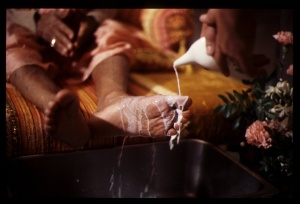CC Madhya 23.57 (1975)

A.C. Bhaktivedanta Swami Prabhupada
Below is the 1996 edition text, ready to be substituted with the 1975 one using the compile form.
TEXT 57
- ’rūḍha’, ‘adhirūḍha’ bhāva—kevala ‘madhure’
- mahiṣī-gaṇera ‘rūḍha’, ‘adhirūḍha’ gopikā-nikare
SYNONYMS
rūḍha—advanced; adhirūḍha—highly advanced; bhāva—ecstasy; kevala—only; madhure—in the transcendental mellow of conjugal love; mahiṣī-gaṇera—of the queens of Dvārakā; rūḍha—advanced; adhirūḍha—highly advanced; gopikā-nikare—among the gopīs.
TRANSLATION
“Only in the conjugal mellow are there two ecstatic symptoms called rūḍha [advanced] and adhirūḍha [highly advanced]. The advanced ecstasies are found among the queens of Dvārakā, and the highly advanced ecstasies are found among the gopīs.
PURPORT
The adhirūḍha ecstasies are explained in the Ujjvala-nīlamaṇi (Sthāyi-bhāva-prakaraṇa 170):
- rūḍhoktebhyo ‘nubhāvebhyaḥ kām apy āptā viśiṣṭatām
- yatrānubhāvā dṛśyante so ‘dhirūḍho nigadyate
The very sweet attraction of conjugal love increases through affection, counterlove, love, attachment, subattachment, ecstasy and highly advanced ecstasy (mahābhāva). The platform of mahābhāva includes rūḍha and adhirūḍha. These platforms are possible only in conjugal love. Advanced ecstasy is found in Dvārakā, whereas highly advanced ecstasy is found among the gopīs.